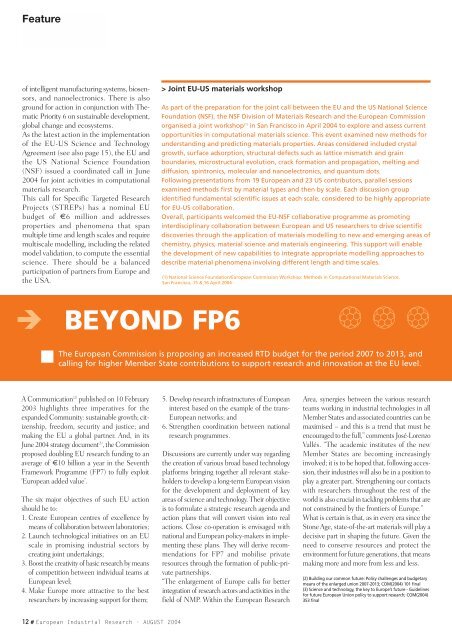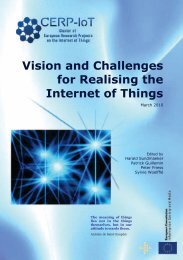August 2004 - European Commission - Europa
August 2004 - European Commission - Europa
August 2004 - European Commission - Europa
Create successful ePaper yourself
Turn your PDF publications into a flip-book with our unique Google optimized e-Paper software.
Feature<br />
of intelligent manufacturing systems, biosensors,<br />
and nanoelectronics. There is also<br />
ground for action in conjunction with Thematic<br />
Priority 6 on sustainable development,<br />
global change and ecosystems.<br />
As the latest action in the implementation<br />
of the EU-US Science and Technology<br />
Agreement (see also page 15), the EU and<br />
the US National Science Foundation<br />
(NSF) issued a coordinated call in June<br />
<strong>2004</strong> for joint activities in computational<br />
materials research.<br />
This call for Specific Targeted Research<br />
Projects (STREPs) has a nominal EU<br />
budget of €6 million and addresses<br />
properties and phenomena that span<br />
multiple time and length scales and require<br />
multiscale modelling, including the related<br />
model validation, to compute the essential<br />
science. There should be a balanced<br />
participation of partners from Europe and<br />
the USA.<br />
<br />
A Communication (2) published on 10 February<br />
2003 highlights three imperatives for the<br />
expanded Community: sustainable growth; citizenship,<br />
freedom, security and justice; and<br />
making the EU a global partner. And, in its<br />
June <strong>2004</strong> strategy document (3) , the <strong>Commission</strong><br />
proposed doubling EU research funding to an<br />
average of €10 billion a year in the Seventh<br />
Framework Programme (FP7) to fully exploit<br />
‘<strong>European</strong> added value’.<br />
The six major objectives of such EU action<br />
should be to:<br />
1. Create <strong>European</strong> centres of excellence by<br />
means of collaboration between laboratories;<br />
2. Launch technological initiatives on an EU<br />
scale in promising industrial sectors by<br />
creating joint undertakings;<br />
3. Boost the creativity of basic research by means<br />
of competition between individual teams at<br />
<strong>European</strong> level;<br />
4. Make Europe more attractive to the best<br />
researchers by increasing support for them;<br />
12 # <strong>European</strong> Industrial Research - AUGUST <strong>2004</strong><br />
> Joint EU-US materials workshop<br />
BEYOND FP6<br />
As part of the preparation for the joint call between the EU and the US National Science<br />
Foundation (NSF), the NSF Division of Materials Research and the <strong>European</strong> <strong>Commission</strong><br />
organised a joint workshop (1) in San Francisco in April <strong>2004</strong> to explore and assess current<br />
opportunities in computational materials science. This event examined new methods for<br />
understanding and predicting materials properties. Areas considered included crystal<br />
growth, surface adsorption, structural defects such as lattice mismatch and grain<br />
boundaries, microstructural evolution, crack formation and propagation, melting and<br />
diffusion, spintronics, molecular and nanoelectronics, and quantum dots.<br />
Following presentations from 19 <strong>European</strong> and 23 US contributors, parallel sessions<br />
examined methods first by material types and then by scale. Each discussion group<br />
identified fundamental scientific issues at each scale, considered to be highly appropriate<br />
for EU-US collaboration.<br />
Overall, participants welcomed the EU-NSF collaborative programme as promoting<br />
interdisciplinary collaboration between <strong>European</strong> and US researchers to drive scientific<br />
discoveries through the application of materials modelling to new and emerging areas of<br />
chemistry, physics, material science and materials engineering. This support will enable<br />
the development of new capabilities to integrate appropriate modelling approaches to<br />
describe material phenomena involving different length and time scales.<br />
(1) National Science Foundation/<strong>European</strong> <strong>Commission</strong> Workshop: Methods in Computational Materials Science,<br />
San Francisco, 15 & 16 April <strong>2004</strong><br />
The <strong>European</strong> <strong>Commission</strong> is proposing an increased RTD budget for the period 2007 to 2013, and<br />
calling for higher Member State contributions to support research and innovation at the EU level.<br />
5. Develop research infrastructures of <strong>European</strong><br />
interest based on the example of the trans-<br />
<strong>European</strong> networks; and<br />
6. Strengthen coordination between national<br />
research programmes.<br />
Discussions are currently under way regarding<br />
the creation of various broad based technology<br />
platforms bringing together all relevant stakeholders<br />
to develop a long-term <strong>European</strong> vision<br />
for the development and deployment of key<br />
areas of science and technology. Their objective<br />
is to formulate a strategic research agenda and<br />
action plans that will convert vision into real<br />
actions. Close co-operation is envisaged with<br />
national and <strong>European</strong> policy-makers in implementing<br />
these plans. They will derive recommendations<br />
for FP7 and mobilise private<br />
resources through the formation of public-private<br />
partnerships.<br />
“The enlargement of Europe calls for better<br />
integration of research actors and activities in the<br />
field of NMP. Within the <strong>European</strong> Research<br />
Area, synergies between the various research<br />
teams working in industrial technologies in all<br />
Member States and associated countries can be<br />
maximised – and this is a trend that must be<br />
encouraged to the full,” comments José-Lorenzo<br />
Vallés. “The academic institutes of the new<br />
Member States are becoming increasingly<br />
involved; it is to be hoped that, following accession,<br />
their industries will also be in a position to<br />
play a greater part. Strengthening our contacts<br />
with researchers throughout the rest of the<br />
world is also crucial in tackling problems that are<br />
not constrained by the frontiers of Europe.”<br />
What is certain is that, as in every era since the<br />
Stone Age, state-of-the-art materials will play a<br />
decisive part in shaping the future. Given the<br />
need to conserve resources and protect the<br />
environment for future generations, that means<br />
making more and more from less and less.<br />
(2) Building our common future: Policy challenges and budgetary<br />
means of the enlarged union 2007-2013; COM(<strong>2004</strong>) 101 final<br />
(3) Science and technology, the key to Europe’s future - Guidelines<br />
for future <strong>European</strong> Union policy to support research; COM(<strong>2004</strong>)<br />
353 final

















